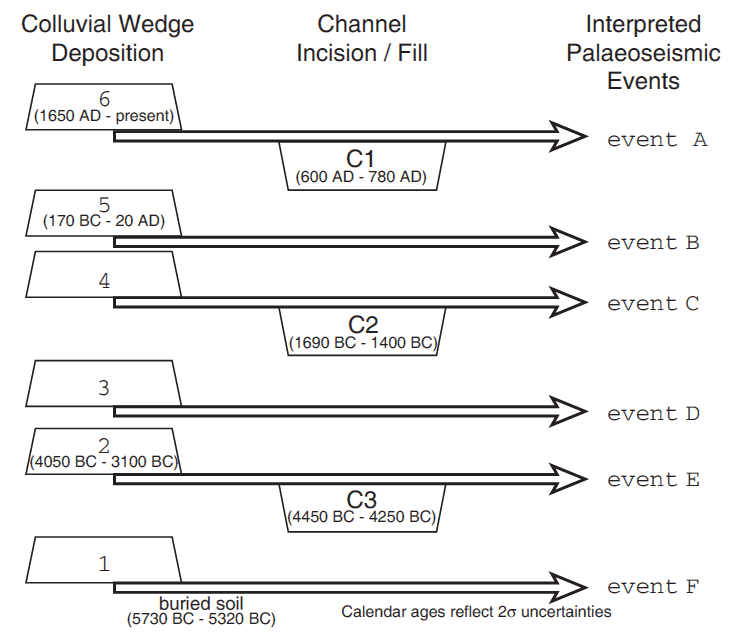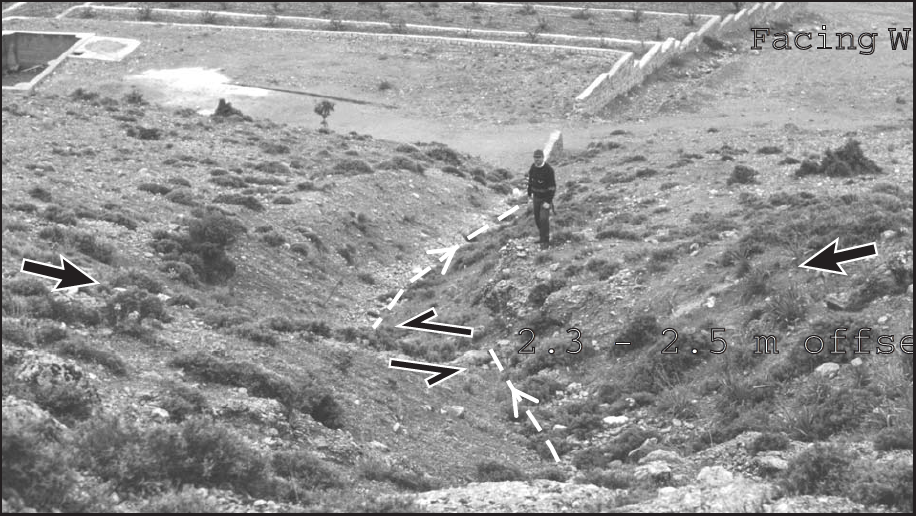Tekieh Trenches
 Figure 13
Figure 13Summary of events observed in the trenches and the interpreted palaeoseismic history of the Serghaya fault. Colluvial wedge deposits post-date palaeoseismic events. Stratigraphic ties provide additional constraint on the relative timing of events. Ages represent calendar corrected radiocarbon ages for given features (2 σ uncertainties provided).
Gomez et al (2003)
- Fig. 2 Tectonic Location
Map from Gomez et al. (2003)

 Fig. 2
Fig. 2
Shaded relief image depicting the gross morphology of the Serghaya fault. Faults and the main anticlinal hinges are shown. Geographic features:
- ZV = Zebadani Valley
- H = Mt Hermon
- D = Damascus
- B = Baalbek
- A = Aarsal
See Fig. 1 for location.
Gomez et al (2003) - Fig. 3 Geologic Location
Map from Gomez et al. (2003)

 Fig. 3
Fig. 3
Geology of the southern Zebadani Valley (Syria). See Fig. 2 for location. Stereonet depicts fault planes and associated striations from faulted Late Pleistocene lake sediments. The dotted line depicts the catchment for the hillslope drainage at the trench site (white square). The white star denotes the excavation of the upper colluvial wedge described in Gomez et al# (2001). White discs denote small drainage deflections (values in metres), including the example shown in Fig. 4. Topographic contour interval = 50 m.
Gomez et al (2003) - Tekieh Trenches in Google Earth
- Fig. 2 Tectonic Location
Map from Gomez et al. (2003)

 Fig. 2
Fig. 2
Shaded relief image depicting the gross morphology of the Serghaya fault. Faults and the main anticlinal hinges are shown. Geographic features:
- ZV = Zebadani Valley
- H = Mt Hermon
- D = Damascus
- B = Baalbek
- A = Aarsal
See Fig. 1 for location.
Gomez et al (2003) - Fig. 3 Geologic Location
Map from Gomez et al. (2003)

 Fig. 3
Fig. 3
Geology of the southern Zebadani Valley (Syria). See Fig. 2 for location. Stereonet depicts fault planes and associated striations from faulted Late Pleistocene lake sediments. The dotted line depicts the catchment for the hillslope drainage at the trench site (white square). The white star denotes the excavation of the upper colluvial wedge described in Gomez et al# (2001). White discs denote small drainage deflections (values in metres), including the example shown in Fig. 4. Topographic contour interval = 50 m.
Gomez et al (2003)

Fig. 5a
Map of trench site. 1 m relative contours are based on mapping with a total station. See Fig. 3 for location.
Gomez et al (2003)

Fig. 5c
Enlarged map of the trench site depicting the positions of the present channel (C1) and the precise locations of the buried channels (C2 and C3). Solid black lines indicate where the buried channels were observed and dashed lines indicate where buried channels were inferred. The patterns are consistent with Fig. 5(a).
Gomez et al (2003)

Fig. 12
Schematic block diagram illustrating the 3-D relationships of the features exposed in the trenches. A stratigraphic tie between the filling deposit of Channel C2 with the down-slope equivalent of Wedge 4 can be observed.
Gomez et al (2003)

Fig. 5b
Topographic profile and cross-section illustrating composite fault scarp approximately 4.5 m in height
Gomez et al (2003)

Fig. 6
Photograph of the trench site facing SE. Note the position of the trench system relative to the fault scarp and the small drainage. See Fig. 3 for location
Gomez et al (2003)

Fig. 8
Trench log for the northern wall of Trench 1 (see Fig. 7), exposing colluvial wedges, undifferentiated alluvium and Late Pleistocene lake sediments. Calibrated radiocarbon ages are shown.
Gomez et al (2003)

Fig. 7
Photomosaic of the north wall of Trench 1.
Gomez et al (2003)

Fig. 11
Cross-sections showing schematic reconstruction of the past five palaeoseismic events indicated in Trench 1. Numbers correspond to colluvial wedges 2-6. Bold lines depict the most recent fault splay in each stage; dashed lines denote restored faults.
- ls = lacustrine sediment
- a =undifferentiated alluvium
Gomez et al (2003)

Fig. 10
Trench log for the east wall of Trench 2. A sequence of three incised and filled channels is shown, with a northward sense of younging. Black discs denote the positions of samples for radiocarbon dating. The profile above the trench log depicts the hillslope channel morphology east of the fault zone. The relative positions of the channel mouth and the buried channels were mapped using a total station. Apparent offsets of the buried channels are shown.
Gomez et al (2003)

Fig. 9
Photo of incised and filled channel exposed in Trench 2. Channel C3 is incised into the older alluvium (unit a) and filled with clast-supported cobble, gravel, and sand. White string grid has 1 m spacing.
Gomez et al (2003)
 Figure 13
Figure 13Summary of events observed in the trenches and the interpreted palaeoseismic history of the Serghaya fault. Colluvial wedge deposits post-date palaeoseismic events. Stratigraphic ties provide additional constraint on the relative timing of events. Ages represent calendar corrected radiocarbon ages for given features (2 σ uncertainties provided).
Gomez et al (2003)

Fig. 14
Plot of offset versus age for buried channels. The 2 m displacement of the youngest channel corresponds to a historically documented earthquake in the early or mid 18th century. The slope of the linear fit is the average Holocene slip rate for the Serghaya fault.
Gomez et al (2003)

Two simplined geometrical models for the restraining bend of the Dead Sea fault system and the role of the Serghaya fault. Predicted plate motion is based on the GPS-derived regional plate model of McClusky et al (2003, in press)
- Decomposing the predicted plate motion into N20E strike-slip fault and orthogonal shortening, the 1.4 mm/yr of slip on the Serghaya fault accounts for ~30 % of the expected strike-slip movement on faults striking N20E. The orthogonal shortening would be accommodated in the Mt Lebanon and/or AntiLebanon Mountains
- An alternative model in which the Serghaya fault acts as an oblique back-stop behind the Palmyride fold belt and contributes to internal deformation of the Arabian plate. The remaining portion of Arabian-African plate motion may then be composed into strike-slip movement (N20E faults) and orthogonal shortening.
Gomez et al (2003)
 Fig. 4
Fig. 4An example of a small, displaced drainage crossing the Serghaya fault. The minimum offset is 2.3 - 2.5 m. The view is facing west; see Fig. 3 for location.
Gomez et al (2003)
Gomez et. al. (2003:15) dated Event A to between
1650 CE and the present and suggested that it was caused by the 1705 or 1759 CE earthquakes.
Daëron et al (2005:531) proposed that the 30 October 1759 earthquake was caused
by slip on the shorter (50 km) Rachaya fault, and the larger magnitude 25 November event was caused by slip on the longer (130
km) Serghaya fault, in keeping with the evidence of recent movement on both (Tapponnier et al., 2001), and the French consul’s letter from Saida
.
This, in turn, they said resolved the ambiguity of Event A in the Tekieh Trench. It was, according to
Daëron et al (2005:531), caused by the 25 Nov. 1759 CE Baalbek Quake.
Daëron et al (2005:531) discussed the triggered earthquakes of 1759 CE as follows:
We interpret the occurrence of two events in 1759 and the month long delay between them as a classic earthquake triggering example. Such triggered delayed rupture may be due to the presence of the Mount Hermon asymmetric push-up jog, a geometric irregularity that prevented immediate rupture propagation along the entire Rachaıya Serghaya fault system. Though not unique, this scenario is in keeping with scaling laws (Wells and Coppersmith, 1994; Ambraseys and Jackson, 1998) that predict (2-sigma) magnitudes of 6.4–7.3 and 7.0–8.0 respectively, compatible with those derived from historical accounts (6.6 and 7.4; Ambraseys and Barazangi, 1989) and from the ~2 m stream channel offset attributed to the last event on the Serghaya fault at Zebadani [i.e., Tekieh trenches] (7.0–7.2 for the November 1759 event; Gomez et al., 2003).Event A is estimated to have created 2 - 2.5 meters of left lateral strike slip displacement which translates to an estimated Magnitude between 7.0 and 7.4.
- Gomez et al (2003:2) reports that left lateral displacement was observed at the site
- Strike-Slip Fault Displacement - Wells and Coppersmith (1994)
| Variable | Input | Units | Notes |
|---|---|---|---|
| m | Strike-Slip displacement | ||
| m | Strike-Slip displacement | ||
| Variable | Output - not considering a Site Effect | Units | Notes |
| unitless | Moment Magnitude for Avg. Displacement | ||
| unitless | Moment Magnitude for Max. Displacement |
Daëron, M. (2005). Role, cinematique et comportement sismique
a long terme de la faille de Yammouneh, principale branche d´
ecrochante du coude transpressif libanais (faille du Levant). eology.
Daëron, M., et al. (2005). "Sources of the large
A.D. 1202 and 1759 Near East earthquakes." Geology 33(7): 529-532.
Gomez, F., et al. (2003). "Holocene faulting and earthquake recurrence along the Serghaya branch of the Dead Sea fault system
in Syria and Lebanon." Geophysical Journal International 153(3): 658-674.
